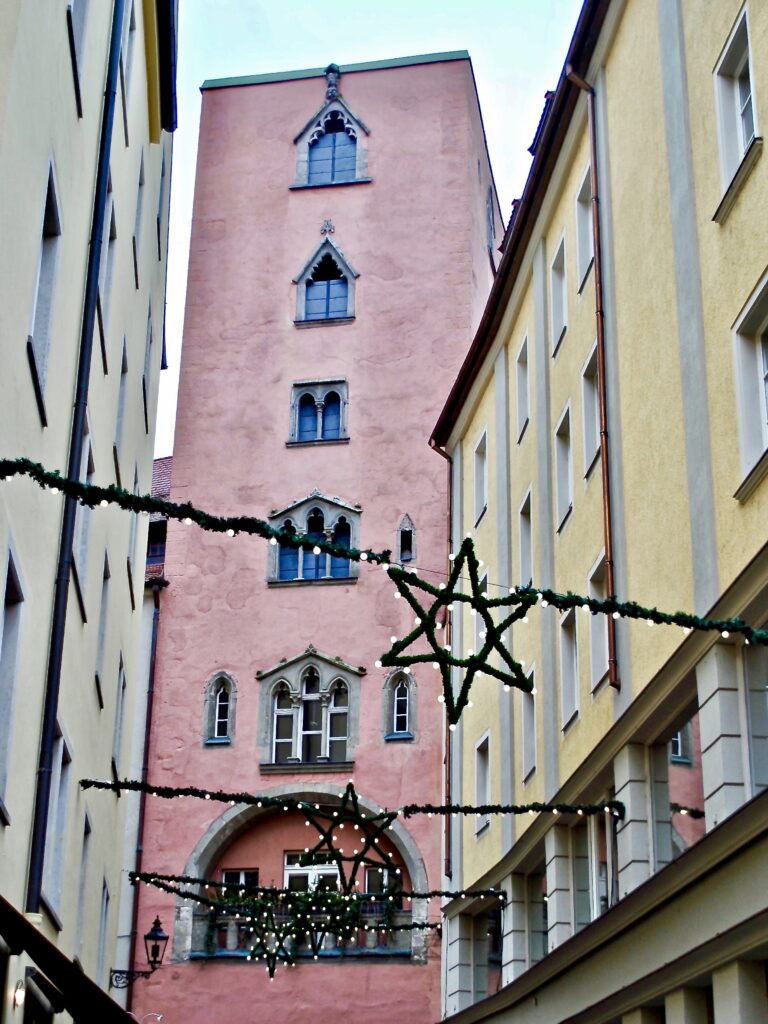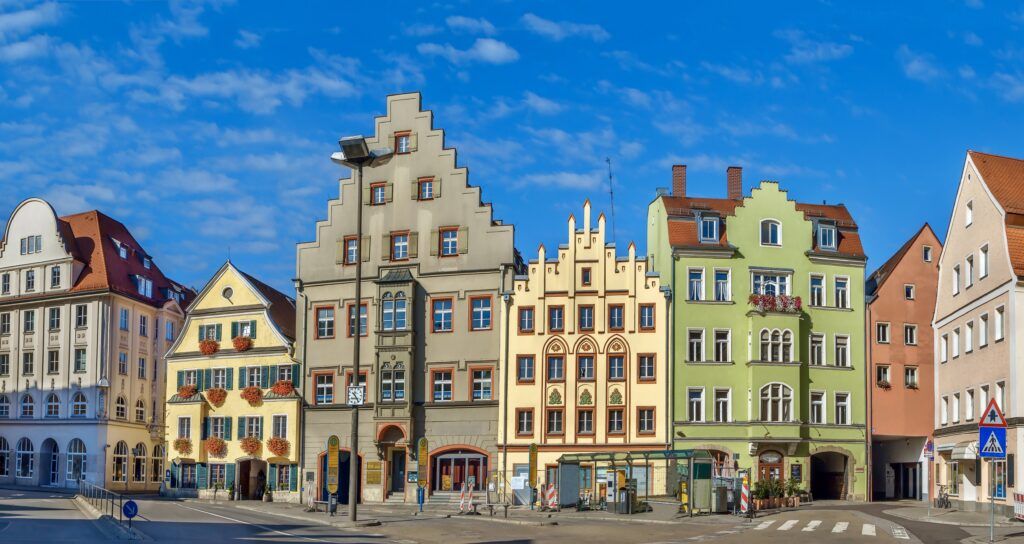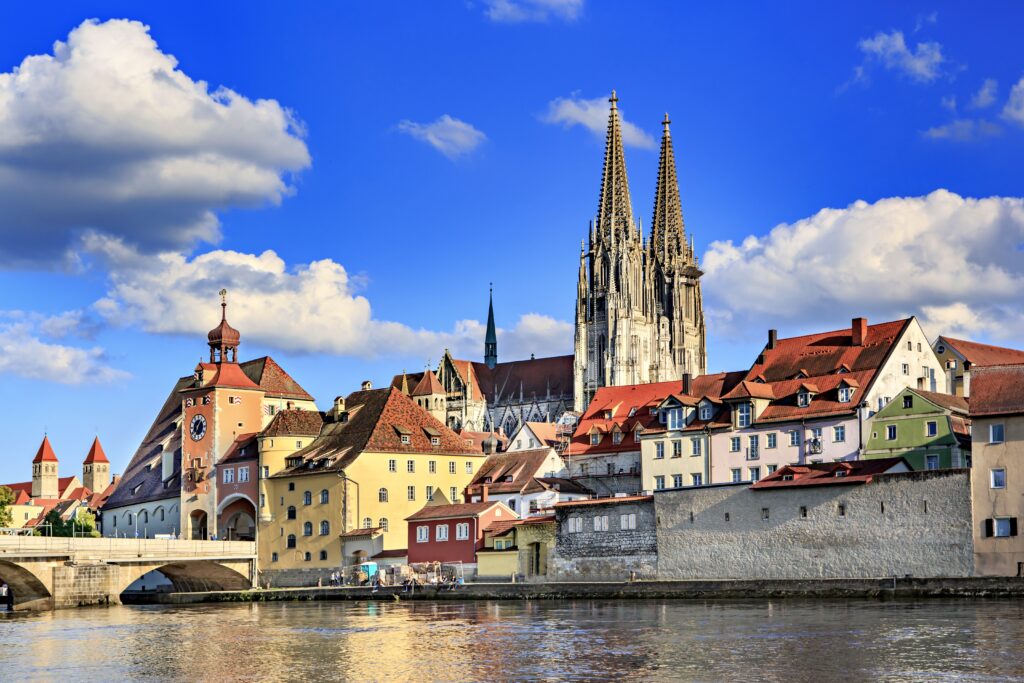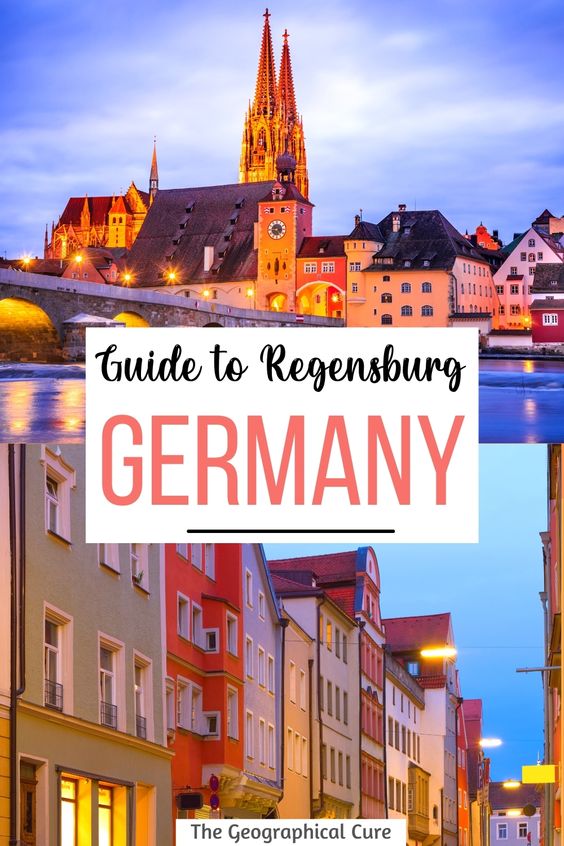Regensburg, a picturesque city on the Danube River in Germany, is a destination well worth visiting. This medieval city is remarkable for having survived wartime bombing, leaving its medieval center gloriously intact.
Unlike many German cities, Regensburg’s historic heart has been so well preserved that it was designated a UNESCO World Heritage site in 2006.
While Regensburg may not be a hidden gem—thanks to its popularity with cruise ships—it’s less frequented compared to other Bavarian towns like Rothenburg ob der Tauber. This relative obscurity makes it all the more appealing for those seeking less crowded destinations.
The city exudes an authentic charm, bustling with locals who enjoy their beautiful surroundings. This genuine atmosphere is particularly attractive to travel enthusiasts who seek a pure experience of local culture.
Known affectionately as the “northernmost city of Italy,” Regensburg is dotted with pointed towers and quaint beer gardens. It boasts a rich history, being 1,000 years older than Munich, the capital of Bavaria.
The city’s most prominent landmark is its magnificent 13th century Gothic cathedral, a structure so grand it’s visible from almost anywhere in the city.
I arrived on a sunny warm day, after a week long cold spell in October. The streets were filled with jubilant Germans, tippling beer and crowding the al fresco cafes. They were merry and seemed happy to be alive.
Mini History of Regensburg
Regensburg is located at the confluence of the Danube, Naab, and Regen rivers. It was first settled during the Stone Age.
In 179 AD, because of Regensburg’s strategic location, the Romans founded a garrison town, then known as Ratisbona. Roman Emperor Marc Aurelius erected a castrum (fortress).
In 739, Regensburg became a bishopric. Shortly thereafter, it became the capital of the Carolingians, a Frankish noble family.
Fast forward, in 1245, Regensburg became a free imperial city, a self-ruling city within the Holy Roman Empire.
In the 13th and 14th centuries, Regensburg merchants grew extremely prosperous. After the Stone Bridge was built, the city was a key stop on the medieval trade route.
In fact, for hundreds of years, it was the only bridge between Ulm and Vienna. Regensburg eventually merged into the kingdom of Bavaria.
You can’t miss the towers in Regensburg. They date from the period of wealth and prestige.
Patrician families competed with each other to built bigger and better towers for their homes. The richer you were, the taller your tower. Some were 12 stories high.

At one point, there were 94 of these so-called “dynasty towers.”
The most impressive one is the Golden Tower, at 50 meters. Often, the towers were for show only and mostly vacant in the upper levels.
Patrick Leigh Fermor, British author and scholar, was impressed with Regensburg’s steeples, opining that they were “wrapped in myth, dominating one of the most complete and convincing medieval cities of the world.”
Despite repeated bombing during WWI, Regensburg survived almost perfectly intact. It’s a city that war couldn’t destroy.

Top Attractions & Things To Do In Regensburg
1. Stroll the Beautiful Old Town
The best thing to do in Regensburg is explore the old town. Regensburg is incredibly picturesque and custom built for aimless wandering.
The streets are filled with lovely churches, hidden nooks, sherbet-colored facades, and endless cafes. You can hang out in front of the cathedral in the Domplatz and admire its gargantuan dimensions.
You may want to opt for a guided walking tour or a private tour to get the complete historical backdrop.
2. Neupfarrplatz and Neupfarrkirche Chapel
Stroll through the Neupfarrplatz and see the Neupfarrkirche Chapel.
The construction of the Neupfarrkirche began in the 16th century, symbolizing a shift in the religious landscape of the city following the Reformation.
The exterior is Gothic. But the interior is rather plain.
If you want a panoramic view, take the elevator in the Galleria Kaufhof to the top.
3. Goliath Haus
Be sure to stroll down the pedestrianized Goliathstrasse too.
There, you’ll find the Goliath Haus. The facade sports a large and beautiful mural of David and Goliath, painted in 1573.
If you’re looking for fine dining, the Michelin starred restaurant Storstad is on the top floor.
On the right side of the mural, you’ll spot a small green frog. Legend holds that the frog represents a rich merchant.
He liked to don a showy green cape and spurs and showboat up and down the street astride his horse. As karma for his obnoxiousness, he lost all his money and was left impoverished.
But, really, it’s best just to get lost in Regensburg’s seemingly endless labyrinthian alleyways. I spent hours in this endeavor, with my head swiveling right and left, peeking into shops, churches, and beer gardens.
As a UNESCO site, the buildings have protected status. By regulation, they can’t be altered.
4. Regensburg Cathedral
The towering Regensburg Cathedral, also known as St. Peters Cathedral, dominates the old town. It’s one of the most important churches in southern Germany. The cathedral dates from 700. But it was destroyed by a fire in 1273.
Reconstruction began in 1275 AD. But the gigantic edifice, built in high Gothic fashion, wasn’t finished until 1869.
Originally, it was envisioned to look like Notre Dame in Paris. But King Ludwig I decided to add two massive spires. The cathedral reminds me of the St. Lorenz Church in Nuremberg.
The exterior is relatively harmonious. But you’ll see differences between the left and right sides of the front facade. The exterior was also recently cleaned, but not hideously over-cleaned, so the cathedral still has an ancient look.
The interior is quite austere and very dark. It’ll take your eyes a few minutes to adjust to the atmospheric Gothic gloom. The canopy vaulting is 32 meters high.
Like many other churches in Germany, the cathedral was “purified” in the middle of the 19th century. It was scrubbed of all Baroque additions to reclaim its original medieval glory.
The cathedral’s stained glass windows are its most stunning feature, and the most beautiful windows I saw in my road trip through Bavaria. The stained glass is original, dating from the 13th and 14th century.
The glass was removed during WWII, and hence preserved. Among other images, you’ll find St. Peter in the south transept, the patron saint of the cathedral.
5. Old Stone Bridge
The Stone Bridge, Steinerne Brücke, is Regensburg’s most important landmark and a fine site. It was built between 1135-46 and was once considered the eighth wonder of the world.
The bridge crosses the Danube, linking Regensburg’s Old Town with the Stadtamhof neighborhood. It was used as model for the Charles Bridge in Prague.
The stone marvel is the oldest medieval bridge in Germany. It consists of 15 arches that become higher and broader in the center, giving it a humpbacked look. In the sunshine, the stone looks almost golden.
The bridge’s “hump” has an interesting backstory. According to legend, the bridge builder and the cathedral builder were in a fierce rivalry to see who could finish their respective edifice first.
The bridge builder broke bad and make a pact with the devil. If Satan would help him win the contest, he would cast three souls into hell.
As you might guess, the bridge builder prevailed. The devil arrived to claim his reward.
But, at the last minute, the builder sacrificed three animals instead. So angry was the devil that he hulked out and tried to uproot the central arch of the bridge, thus giving it its characteristic hump.
No ships cross under the bridge anymore. And cars are likewise banned.
You’ll just find camera clicking crowds and a periodic bus trundling over the cobbles. The bridge offers gorgeous views of Regensburg’s urban panorama.
6. Old Town Hall, Altes Rathaus
When Regensburg became a free imperial city in 1230, the rich patricians immediately built a swishy Town Hall in Old Cornmarket square.
The building was continuously enlarged in the ensuing years. The “Imperial Diet” meetings of the Holy Roman Empire were often held in its Imperial Hall.
The Imperial Diet (such an odd term!) began in 777.
A parliament of nobles met behind closed doors in a German city to discuss affairs of state and resolve political crises. It was essentially a precursor to the present day German legislature.
After 1594, the Diet only met in Regensburg and was thereafter dubbed the “Eternal Diet.” In 1830, Napoleon disbanded the diet entirely, greedy for power himself.
The Town Hall also has one of the few remaining authentic torture chambers in Europe, used until 1770.
The so-called “painful questioning” was reserved for capital offenses. It’s filled with racks, torture devices, and a dark cell for drunken nobles.
You can only visit the Town Hall and Imperial Diet Museum on a 60 minute guided tour. Tickets are sold at the Tourist Information Center on the ground floor.
7. Schloss St. Emmeram & St. Emmeram Abbey
In 1812, St. Emmeram Abbey (dating from 780) was dissolved and handed over to the Princes Thurn and Taxis. In the middle ages, the aristocratic family were initially robber barons and pirates.
Later, it had a monopoly on the horse courier and post system to deliver mail in Germany. When the the post system was centralized, the family received the monastery as compensation.
The Thurn and Taxis converted the monastery into a fancy schloss. It’s a rambling behemoth estate with semi-mismatched exterior architecture and 500 rooms.
In the 1990s, the interior was renovated in fine style by Gloria von Thurn und Taxis, nicknamed the “punk princess” for combining formal evening garb with new wave hair styles.
You’ll find portraits of the famous Empress Sisi throughout the palace. Sisi was a Bavarian princess, of the Wittelsbach family, reluctantly married off to Emperor Franz Joseph of Austria.
In fact, it was Sisi’s sister Helene who was supposed to marry the emperor, not Sisi. As a consolation prize, Helene was wed to the wealthy Prince Maximilian von Thurn and Taxis instead and moved to Regensburg.
In a fit of sibling rivalry, Helene may have wanted her palace to be as swishy as Sisi’s palaces in Austria. I think Helene succeeded.
It’s elegant and more tasteful than the Hapsburg Palaces (which, in fairness, were more the creation of Empress Maria Theresa than Sisi.)
You can visit parts of the must see St. Emmeram’s Palace on a guided tour. The tour’s in German, but there is an English audio guide.
From November 29 to December 23, the palace courtyard is the stage for a magical Christmas Market, plucked straight out of a storybook.
It’s known locally as the “Romantic Market.” Her Highness Gloria of Thurn und Taxis tells the “Christmas Story.”
Most of the St. Emmermam Abbey was transformed into the schloss. But the church, dating from 780, is still there.
And it’s lovely. In 1733, the brothers Cosmas Damia and Egid Asam transformed the interior into a Baroque masterpiece with colorful frescos, beautiful stucco work, and lavish gold embellishments.
8. Porta Praetoria
Don’t miss the the famous Porta Praetoria. The former Roman gate is a remnant from “Castra Regina,” or “fortress by the river Regan.”
It was built under the reign of Marcus Aurelius. It’s a nice example of historical preservation, effectively embedded into the city infrastructure.
It was discovered in 1885 during renovations to the Bischof Brewery. It’s now part of one of the best hotels in Regensburg, aptly named the Porta Praetoria.
If you walk through the gate, you’ll have a good view of the back of Regensburg Cathedral.
9. Historiches Museum
The Regensburg Museum of History is housed in a former Minorite monastery.
It showcases the history, art and culture of Regensburg from the Stone Age to the present day.
Make sure to see The Two St. Johns painting by Albrecht Altdorfer. Associated with Regensburg’s heyday, Altdorfer was the leading exponent of the Danube School.
These painters rejected the rigidity and high finish of traditional Northern Renaissance painting. Instead, they favored moody landscapes with expressive swirls of color.
Most of Altdorfer’s work is in the Alte Pinakotek in Munich.
But you can feast your eyes on The Two St. Johns. In it, two saints chat against a luxuriant landscape while Mary watches from on high.
10 Stadtamhof, Across the Stone Bridge
Across the 12th century Stone Bridge is the other half of Regensburg, the more peaceful Stadtamhof neighborhood. Its main street is a delightful rainbow of pretty pastel colored houses.
You’ll find the quaint St. Mang Kirche there. And a fine collection of bars, restaurants, and small shops.
People lounge along the river banks, drinking beer, reading books, or just enjoying the sunshine. I certainly did.
11. Try the Local Cuisine
One of the best things to do in Regensburg is eat! The city is known for salt, sweet and spicy mustard, and chocolate.
Buy mustard at Handlmaier’s Laden. Sample chocolate at the ritzy Cafe Prinzess, the oldest coffee house in Germany, launched in 1686.
Eat a knacker, which consists of sausage, sweet mustard, and pickles on a bun. The best place to try one is at the historic Wurstkuchl. It’s an ancient sausage kitchen by the river, which was originally built for those devilish bridge builders.
The small restaurant only seats 35. Its guests, who buy 6,000 sausages daily (after waiting in line), sit outside at wooden tables.
Another local delicacy is the Streuseltaler. It’s a German pastry consisting of sweet yeasty cake, loaded with streusel and vanilla glaze.
12. Beer Gardens
Regensburg is filled with cute beer gardens as well!
If you want beer with a view (who doesn’t?), try Spital Biergarten. It’s halfway across the Stone Bridge on a tiny island that juts out endearingly.
13. Visit the Famous Hat Shop
If you’re a Disney fan or adore a finely crafted hat, visit the shop of Hütkonig Der Hutmacher. It’s a famous hat store in Regensburg.
The hat maker, Andreas Nuslan, has created hats for royalty, presidents, and celebrities.
He even was asked to make the hat Johnny Depp wore as the mad hatter in Alice in Wonderland. The famous Disney mad hatter hat is on display in the store.
After admiring the hats, check out the gorgeous view from the women’s hat section.
14. Visit Walhalla, the German Hall of Fame
Walhalla is a 19th century Neo-Classical memorial in the suburb of Donaustauf, built to honor celebrities “of the German tongue.” Crown Prince Ludwig of Bavaria envisioned the memorial as a German hall of fame.
He sought to assemble busts, paintings, and plaques of the greatest artists, composers, writers, and politicians. Collectively, they would represent the “German soul.”
Walhalla was finished by architect Leo von Klenze in 1842. It now houses 2,000 artifacts. You’ll see a bewigged Bach, a jowly Brahms, and a chin-thrusting Wagner.
The building itself is kind a dud in my opinion, though it’s meant to impress. It’s a rather vulgar whitewashed monument that looks like a scrap of the Parthenon was air dropped into a verdant forest.
It’s got heavy columns and a grandiose flight of stairs leading up from the river, a tiny bit reminiscent of Hitler’s “zeppelin grandstand” in Nuremberg.
The upside of visiting Walhalla? You have a killer panoramic view of the Danube River.
You can get to Walhalla by driving, biking, taking bus #5, or by boat. The bus takes about 20 minutes and you get off at Donaustauf.
Tips For Visiting Regensburg
How To Get To Regensburg
Regensburg is located in the northeastern part of Bavaria, roughly 45 minutes from the Czech border.
If you’re coming by river cruise, you have accommodation and perhaps a pre-planned tour. Cruises arrive at the port just outside the city and provide transport into the old town.
The nearest airports to Regensburg are Munich, Nuremberg, and Stuttgart. From there, you’ll need to rent a car to reach Regensburg.
If you arrive by car, which I did, park at Dachauplatz. It’s the closest parking garage to the old town.
There’s also a 90 minute train from Munich or a 30 minute train direct from Nuremberg.
From the train station, start walking down Maximilianstrasse, the main shopping street. It’s not the main attraction, but will lead you to the main attractions in the old town.
Many people visit Regensburg on a guided tour from Munich, to leave the logistics to someone else.

Where To Stay In Regensburg
Think you might stay overnight in Regensburg? There are some good nests to lay your head.
The Hotel Goliath Am Dom Regensburg is centrally located with colorful rooms and a roof terrace. The Bohemian Hotel is a romantic boutique hotel in a historic building. Hotel Rote 19 is an elegant and well designed hotel near the Old Stone Bridge.
I hope you’ve enjoyed my guide to the top attractions in Regensburg. You may enjoy these other travel guides and resources for Germany:
- 10 Days in Bavaria Germany
- Guide To Germany’s Romantic Road
- 4 Days in Munich Itinerary
- 1 Day in Munich Itinerary
- Guide To Neuschwanstein Castle
- Prettiest Towns in Germany
- Tips For Visiting Germany
- Guide To Rothenburg ob der Tauber
- Guide To Fairytale Castles in Bavaria
Pin it for later.

